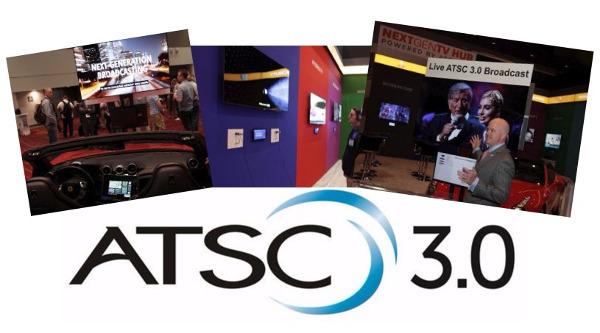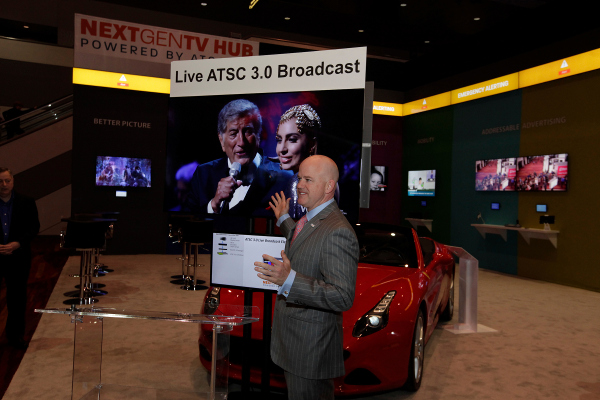ATSC 3.0: TV’s Next Generation

In the age of internet-delivered entertainment, it’s easy to lose sight of the power of broadcast TV—that woefully underutilized bastion of free HD-quality programming. A few decades ago, rabbit ears and roof-mounted antennas were a staple in American homes. Today, about 11 percent of American households get TV over the air and another 9 or so percent rely exclusively on the internet for TV. Both categories are growing (the latter far more dramatically) as the we’re-tired-of-stupidly-high-cable-bills “cord-cutting” movement gains momentum. All of which brings us to ATSC 3.0, hailed by its proponents as a revolution in technology that will transform TV broadcasting by bringing together internet and over-the-air signals with a common IP backbone. We reached out to Mark Richer, president of the Advanced Television Systems Committee, to learn more.
 S&V: Let’s start with a brief overview of the Advanced Television Systems Committee—what it is and the role it plays in developing the technology behind our broadcast TV system.
S&V: Let’s start with a brief overview of the Advanced Television Systems Committee—what it is and the role it plays in developing the technology behind our broadcast TV system.
Mark Richer: Rewinding back to the 1950s, the National Television Systems Committee (NTSC) developed black-and-white-compatible color television in 1953. Nearly 30 years later—in 1982—the Advanced Television Systems Committee (ATSC) began with the idea of updating broadcast TV standards for a new age—a digital age. The committee developed the transmission standard for digital TV in the U.S., which was approved by the Federal Communications Commission (FCC) in 1996, and continues to work as technology evolves. We’re now putting the finishing touches on what we call ATSC 3.0, or NextGen TV.
S&V: Work on ATSC 3.0 has been underway from some time. In big-picture terms, what is ATSC 3.0 and how does it differ from the current standard?
Richer: A lot has changed since the FCC officially adopted the ATSC standard for U.S. broadcasters in December 1996. No one had a smartphone back then and the internet was still in its infancy. In order to stay competitive, broadcasters several years ago began developing the framework for a service that would work with the internet (which became ATSC 2.0.) But additional changes in online TV viewing habits, the emergence of 4K, and the move to Internet Protocol (IP) made it necessary to leapfrog ahead to ATSC 3.0. The new standard is designed to seamlessly combine over-the-air television transmissions with over-the-top content from the internet. It will deliver a better experience for viewers, and also allow broadcasters to utilize addressable advertising and better measure who is watching which programs.
ATSC 3.0 will allow for exciting new features, including the ability to zoom in and choose camera angles when watching sports.
S&V: In addition to improved 4K picture quality, what does ATSC 3.0 bring to the table that our readers can get excited about?Richer: There are several key attributes of ATSC 3.0 that will benefit both viewers and broadcasters. Better pictures are coming with the capability of transmitting 4K as well as content with high dynamic range, high frame rate, and wider color gamut. Immersive audio with Dolby AC-4 in the U.S. (and MPEG-H audio in other parts of the world) is part of the standard, as is the ability to merge internet-delivered and broadcast-delivered content. Americans are expected to buy more than 15 million 4K/Ultra HDTV sets this year, and we’re building out the capability for broadcasters to deliver better pictures and immersive audio to viewers.
S&V: So does that mean ATSC 3.0 will accommodate Dolby Atmos and DTS:X?
Richer: Individual technology proponents would have to answer specific questions about compatibility. [Editor’s note: Dolby confirmed that as long as the television has an ATSC 3.0 tuner that supports Dolby AC-4, no additional hardware will be required to decode Dolby Atmos. DTS:X, on the other hand, is not accounted for in the standard.] ATSC 3.0 will also allow for exciting new features that will provide convenience, personalization, and greater control over content. Examples include the ability to start programs at the beginning even after they have already started, zoom in and choose camera angles when watching sports, create custom home screens based on preferences, and receive alerts when favorite shows, sporting events, or weather reports are airing. The standard will also support fast-forwarding and rewinding with any show or sporting event, a personalized on-screen guide with recommendations, and on-screen search of video-on-demand, streaming services, and programs delivered over the air.

S&V: How will ATSC 3.0 address the “TV everywhere” reality of today’s video entertainment?
Richer: The new standard is flexible, robust, and mobile. One of its key attributes is the ability for a broadcaster to greatly enhance reception and robustness. That means mobility can be part of an ATSC 3.0 transmission from the beginning, giving rise to a new type of mobile tablet and smartphone receiver (if those devices include ATSC 3.0 reception electronics.) So for the living room, there’s the benefit of 4K and high dynamic range. For the viewer on the go, there’s taking your favorite live content with you wherever you go.
S&V: What non-entertainment features does 3.0 offer?
Richer: Advanced emergency alerting, or AWARN for Advanced Warning and Response Network, will deliver rich media alerts in times of emergency and might even result in consumer devices that awake automatically in an emergency. Maps, live video, instructions, and more will come with this new type of emergency system. At the recent NAB Show, the NAB’s Pilot lab showed how an AMBER Alert for a missing child might be transmitted to a car, helping to expedite the recovery of an abducted child. ATSC 3.0 will also allow broadcasters to deliver data to other devices, since its backbone is entirely IP-based.
S&V: Let’s talk about what the transition to ATSC 3.0 will look like.
Richer: The transition from analog to digital was mandated by the government and most analog TV broadcasts were turned off in June 2009. But the transition to ATSC 3.0 is envisioned as voluntary to insure that current ATSC 1.0 broadcasts stay on the air. This will require a great deal of cooperation among broadcasters in a given TV market but it will allow an orderly upgrade to the new service while maintaining the old one.

S&V: FCC Chairman Ajit Pai said the agency hopes to authorize the new standard by the end of the year. What potential sticking points or roadblocks do you see?
Richer: The FCC is going through a normal process, vetting questions with the affected industries. Based on the comments from Chairman Pai, we do not anticipate any major roadblocks. Broadcasters have asked for permission to voluntarily transmit in ATSC 3.0, while taking care of current viewers by working cooperatively to keep ATSC 1.0 signals “on the air” in a given market.
S&V: How many experimental ATSC 3.0 stations are up and running?
Richer: WRAL-TV in Raleigh, North Carolina (run by Capitol Broadcasting) has been “on the air” for nearly a year, transmitting video in 4K with high dynamic range. Experimental stations have also been on the air in Cleveland, Baltimore, and in Portland, Oregon. Broadcasters say they’re learning a lot about what it takes to take advantage of ATSC 3.0’s more robust signals and mobile capability.
S&V: If everything goes according to plan, how many ATSC 3.0 stations do you expect to see on the air in 2018 and 2019? And will the 2018 Winter Olympics in South Korea be the first major ATSC 3.0 broadcast event?
Richer: Korea is certainly leading the way with ATSC 3.0, having introduced the transmission system in May in preparation for the Winter Olympics. The first ATSC 3.0-equipped TV receivers are also being introduced in Korea. In America, we’re hopeful that the FCC will soon approve the voluntary introduction of ATSC 3.0 service over U.S. airwaves. We expect the rollout of the new transmission system to begin in earnest in 2018. But unlike the previous analog-to-digital transition, the voluntary move to ATSC 3.0 will require broadcasters to collaborate to insure that ATSC 1.0 viewers aren’t left behind. In that way, this technology transition will be more complicated than the move from analog to digital service. But the benefits of ATSC 3.0, merging the best functions of over-the-air with over-the-top, will certainly be appealing to both viewers and broadcasters alike.
























































